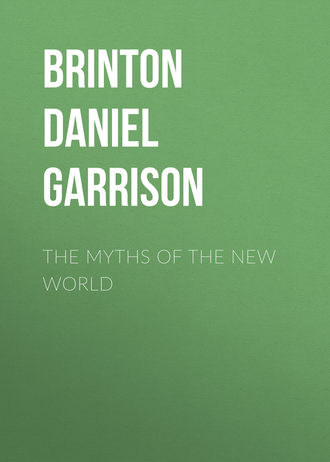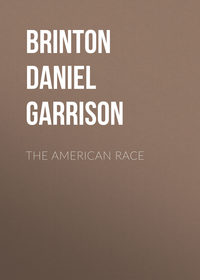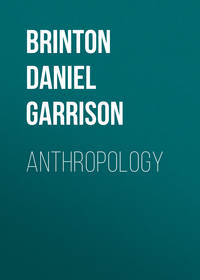 полная версия
полная версияThe Myths of the New World
Poor as these substitutes for a developed phonetic system seem to us, they were of great value to the uncultivated man. In his legends their introduction is usually ascribed to some heaven-sent benefactor, the antique characters were jealously adhered to, and the pictured scroll of bark, the quipu ball, the belt of wampum, were treasured with provident care, and their import minutely expounded to the most intelligent of the rising generation. In all communities beyond the stage of barbarism a class of persons was set apart for this duty and no other. Thus, for example, in ancient Peru, one college of priests styled amauta, learned, had exclusive charge over the quipus containing the mythological and historical traditions; a second, the haravecs, singers, devoted themselves to those referring to the national ballads and dramas; while a third occupied their time solely with those pertaining to civil affairs. Such custodians preserved and prepared the archives, learned by heart with their aid what their fathers knew, and in some countries, as, for instance, among the Panos mentioned above, and the Quiches of Guatemala,10 repeated portions of them at times to the assembled populace. It has even been averred by one of their converted chiefs, long a missionary to his fellows, that the Chipeways of Lake Superior have a college composed of ten “of the wisest and most venerable of their nation,” who have in charge the pictured records containing the ancient history of their tribe. These are kept in an underground chamber, and are disinterred every fifteen years by the assembled guardians, that they may be repaired, and their contents explained to new members of the society.11
In spite of these precautions, the end seems to have been very imperfectly attained. The most distinguished characters, the weightiest events in national history faded into oblivion after a few generations. The time and circumstances of the formation of the league of the Five Nations, the dispersion of the mound builders of the Ohio valley in the fifteenth century, the chronicles of Peru or Mexico beyond a century or two anterior to the conquest, are preserved in such a vague and contradictory manner that they have slight value as history. Their mythology fared somewhat better, for not only was it kept fresh in the memory by frequent repetition; but being itself founded in nature, it was constantly nourished by the truths which gave it birth. Nevertheless, we may profit by the warning to remember that their myths are myths only, and not the reflections of history or heroes.
Rising from these details to a general comparison of the symbolic and phonetic systems in their reactions on the mind, the most obvious are their contrasted effects on the faculty of memory. Letters represent elementary sounds, which are few in any language, while symbols stand for ideas, and they are numerically infinite. The transmission of knowledge by means of the latter is consequently attended with most disproportionate labor. It is almost as if we could quote nothing from an author unless we could recollect his exact words. We have a right to look for excellent memories where such a mode is in vogue, and in the present instance we are not disappointed. “These savages,” exclaims La Hontan, “have the happiest memories in the world!” It was etiquette at their councils for each speaker to repeat verbatim all his predecessors had said, and the whites were often astonished and confused at the verbal fidelity with which the natives recalled the transactions of long past treaties. Their songs were inexhaustible. An instance is on record where an Indian sang two hundred on various subjects.12 Such a fact reminds us of a beautiful expression of the elder Humboldt: “Man,” he says, “regarded as an animal, belongs to one of the singing species; but his notes are always associated with ideas.” The youth who were educated at the public schools of ancient Mexico—for that realm, so far from neglecting the cause of popular education, established houses for gratuitous instruction, and to a certain extent made the attendance upon them obligatory—learned by rote long orations, poems, and prayers with a facility astonishing to the conquerors, and surpassing anything they were accustomed to see in the universities of Old Spain. A phonetic system actually weakens the retentive powers of the mind by offering a more facile plan for preserving thought. “Ce que je mets sur papier, je remets de ma mémoire” is an expression of old Montaigne which he could never have used had he employed ideographic characters.
Memory, however, is of far less importance than a free activity of thought, untrammelled by forms or precedents, and ever alert to novel combinations of ideas. Give a race this and it will guide it to civilization as surely as the needle directs the ship to its haven. It is here that ideographic writing reveals its fatal inferiority. It is forever specifying, materializing, dealing in minutiæ. In the Egyptian symbolic alphabet there is a figure for a virgin, another for a married woman, for a widow without offspring, for a widow with one child, two children, and I know not in how many other circumstances, but for woman there is no sign. It must be so in the nature of things, for the symbol represents the object as it appears or is fancied to appear, and not as it is thought. Furthermore, the constant learning by heart infallibly leads to slavish repetition and mental servility.
A symbol when understood is independent of language, and is as universally current as an Arabic numeral. But this divorce of spoken and written language is of questionable advantage. It at once destroys all permanent improvement in a tongue through elegance of style, sonorous periods, or delicacy of expression, and the life of the language itself is weakened when its forms are left to fluctuate uncontrolled. Written poetry, grammar, rhetoric, all are impossible to the student who draws his knowledge from such a source.
Finally, it has been justly observed by the younger Humboldt that the painful fidelity to the antique figures transmitted from barbarous to polished generations is injurious to the æsthetic sense, and dulls the mind to the beautiful in art and nature.
The transmission of thought by figures and symbols would, on the whole, therefore, foster those narrow and material tendencies which the genius of polysynthetic languages would seem calculated to produce. Its one redeeming trait of strengthening the memory will serve to explain the strange tenacity with which certain myths have been preserved through widely dispersed families, as we shall hereafter see.
Besides this of language there are two traits in the history of the red man without parallel in that of any other variety of our species which has achieved any notable progress in civilization.
The one is his isolation. Cut off time out of mind from the rest of the world, he never underwent those crossings of blood and culture which so modified and on the whole promoted the growth of the old world nationalities. In his own way he worked out his own destiny, and what he won was his with a more than ordinary right of ownership. For all those old dreams of the advent of the Ten Lost Tribes, of Buddhist priests, of Welsh princes, or of Phenician merchants on American soil, and there exerting a permanent influence, have been consigned to the dustbin by every unbiased student, and when we see such men as Mr. Schoolcraft and the Abbé E. C. Brasseur essaying to resuscitate them, we regretfully look upon it in the light of a literary anachronism.
The second trait is the entire absence of the herdsman’s life with its softening associations. Throughout the continent there is not a single authentic instance of a pastoral tribe, not one of an animal raised for its milk,13 nor for the transportation of persons, and very few for their flesh. It was essentially a hunting race. The most civilized nations looked to the chase for their chief supply of meat, and the courts of Cuzco and Mexico enacted stringent game and forest laws, and at certain periods the whole population turned out for a general crusade against the denizens of the forest. In the most densely settled districts the conquerors found vast stretches of primitive woods.
If we consider the life of a hunter, pitting his skill and strength against the marvellous instincts and quick perceptions of the brute, training his senses to preternatural acuteness, but blunting his more tender feelings, his sole aim to shed blood and take life, dependent on luck for his food, exposed to deprivations, storms, and long wanderings, his chief diet flesh, we may more readily comprehend that conspicuous disregard of human suffering, those sanguinary rites, that vindictive spirit, that inappeasable restlessness, which we so often find in the chronicles of ancient America. The law with reason objects to accepting a butcher as a juror on a trial for life; here is a whole race of butchers.
The one mollifying element was agriculture. On the altar of Mixcoatl, god of hunting, the Aztec priest tore the heart from the human victim and smeared with the spouting blood the snake that coiled its lengths around the idol; flowers and fruits, yellow ears of maize and clusters of rich bananas decked the shrine of Centeotl, beneficent patroness of agriculture, and bloodless offerings alone were her appropriate dues. This shows how clear, even to the native mind, was the contrast between these two modes of subsistence. By substituting a sedentary for a wandering life, by supplying a fixed dependence for an uncertain contingency, and by admonishing man that in preservation, not in destruction, lies his most remunerative sphere of activity, we can hardly estimate too highly the wide distribution of the zea mays. This was their only cereal, and it was found in cultivation from the southern extremity of Chili to the fiftieth parallel of north latitude, beyond which limits the low temperature renders it an uncertain crop. In their legends it is represented as the gift of the Great Spirit (Chipeways), brought from the terrestrial Paradise by the sacred animals (Quiches), and symbolically the mother of the race (Nahuas), and the material from which was moulded the first of men (Quiches).
As the races, so the great families of man who speak dialects of the same tongue are, in a sense, individuals, bearing each its own physiognomy. When the whites first heard the uncouth gutturals of the Indians, they frequently proclaimed that hundreds of radically diverse languages, invented, it was piously suggested, by the Devil for the annoyance of missionaries, prevailed over the continent. Earnest students of such matters—Vater, Duponceau, Gallatin, and Buschmann—have, however, demonstrated that nine-tenths of the area of America, at its discovery, were occupied by tribes using dialects traceable to ten or a dozen primitive stems. The names of these, their geographical position in the sixteenth century, and, so far as it is safe to do so, their individual character, I shall briefly mention.
Fringing the shores of the Northern Ocean from Mount St. Elias on the west to the Gulf of St. Lawrence on the east, rarely seen a hundred miles from the coast, were the Eskimos.14 They are the connecting link between the races of the Old and New Worlds, in physical appearance and mental traits more allied to the former, but in language betraying their near kinship to the latter. An amphibious race, born fishermen, in their buoyant skin kayaks they brave fearlessly the tempests, make long voyages, and merit the sobriquet bestowed upon them by Von Baer, “the Phenicians of the north.” Contrary to what one might suppose, they are, amid their snows, a contented, light-hearted people, knowing no longing for a sunnier clime, given to song, music, and merry tales. They are cunning handicraftsmen to a degree, but withal wholly ingulfed in a sensuous existence. The desperate struggle for life engrosses them, and their mythology is barren.
South of them, extending in a broad band across the continent from Hudson’s Bay to the Pacific, and almost to the Great Lakes below, is the Athapascan stock. Its affiliated tribes rove far north to the mouth of the Mackenzie River, and wandering still more widely in an opposite direction along both declivities of the Rocky Mountains, people portions of the coast of Oregon south of the mouth of the Columbia, and spreading over the plains of New Mexico under the names of Apaches, Navajos, and Lipans, almost reach the tropics at the delta of the Rio Grande del Norte, and on the shores of the Gulf of California. No wonder they deserted their fatherland and forgot it altogether, for it is a very terra damnata, whose wretched inhabitants are cut off alike from the harvest of the sea and the harvest of the soil. The profitable culture of maize does not extend beyond the fiftieth parallel of latitude, and less than seven degrees farther north the mean annual temperature everywhere east of the mountains sinks below the freezing point.15 Agriculture is impossible, and the only chance for life lies in the uncertain fortunes of the chase and the penurious gifts of an arctic flora. The denizens of these wilds are abject, slovenly, hopelessly savage, “at the bottom of the scale of humanity in North America,” says Dr. Richardson, and their relatives who have wandered to the more genial climes of the south are as savage as they, as perversely hostile to a sedentary life, as gross and narrow in their moral notions. This wide-spread stock, scattered over forty-five degrees of latitude, covering thousands of square leagues, reaching from the Arctic Ocean to the confines of the empire of the Montezumas, presents in all its subdivisions the same mental physiognomy and linguistic peculiarities.16
Best known to us of all the Indians are the Algonkins and Iroquois, who, at the time of the discovery, were the sole possessors of the region now embraced by Canada and the eastern United States north of the thirty-fifth parallel. The latter, under the names of the Five Nations, Hurons, Tuscaroras, Susquehannocks, Nottoways and others, occupied much of the soil from the St. Lawrence and Lake Ontario to the Roanoke, and perhaps the Cherokees, whose homes were in the secluded vales of East Tennessee, were one of their early offshoots.17 They were a race of warriors, courageous, cruel, unimaginative, but of rare political sagacity. They are more like ancient Romans than Indians, and are leading figures in the colonial wars.
The Algonkins surrounded them on every side, occupying the rest of the region mentioned and running westward to the base of the Rocky Mountains, where one of their famous bands, the Blackfeet, still hunts over the valley of the Saskatchewan. They were more genial than the Iroquois, of milder manners and more vivid fancy, and were regarded by these with a curious mixture of respect and contempt. Some writer has connected this difference with their preference for the open prairie country in contrast to the endless and sombre forests where were the homes of the Iroquois. Their history abounds in great men, whose ambitious plans were foiled by the levity of their allies and their want of persistence. They it was who under King Philip fought the Puritan fathers; who at the instigation of Pontiac doomed to death every white trespasser on their soil; who led by Tecumseh and Black Hawk gathered the clans of the forest and mountain for the last pitched battle of the races in the Mississippi valley. To them belonged the mild mannered Lenni Lenape, who little foreboded the hand of iron that grasped their own so softly under the elm tree of Shackamaxon, to them the restless Shawnee, the gypsy of the wilderness, the Chipeways of Lake Superior, and also to them the Indian girl Pocahontas, who in the legend averted from the head of the white man the blow which, rebounding, swept away her father and all his tribe.18
Between their southernmost outposts and the Gulf of Mexico were a number of clans, mostly speaking the Muscogee tongue, Creeks, Choctaws, Chikasaws, and others, in later times summed up as Apalachian Indians, but by early writers sometimes referred to as “The Empire of the Natchez.” For tradition says that long ago this small tribe, whose home was in the Big Black country, was at the head of a loose confederation embracing most of the nations from the Atlantic coast quite into Texas; and adds that the expedition of De Soto severed its lax bonds and shook it irremediably into fragments. Whether this is worth our credence or not, the comparative civilization of the Natchez, and the analogy their language bears to that of the Mayas of Yucatan, the builders of those ruined cities which Stephens and Catherwood have made so familiar to the world, attach to them a peculiar interest.19
North of the Arkansas River on the right bank of the Mississippi, quite to its source, stretching over to Lake Michigan at Green Bay, and up the valley of the Missouri west to the mountains, resided the Dakotas, an erratic folk, averse to agriculture, but daring hunters and bold warriors, tall and strong of body.20 Their religious notions have been carefully studied, and as they are remarkably primitive and transparent, they will often be referred to. The Sioux and the Winnebagoes are well-known branches of this family.
We have seen that Dr. Richardson assigned to a portion of the Athapascas the lowest place among North American tribes, but there are some in New Mexico who might contest the sad distinction, the Root Diggers, Comanches and others, members of the Snake or Shoshonee family, scattered extensively northwest of Mexico. It has been said of a part of these that they are “nearer the brutes than probably any other portion of the human race on the face of the globe.”21 Their habits in some respects are more brutish than those of any brute, for there is no limit to man’s moral descent or ascent, and the observer might well be excused for doubting whether such a stock ever had a history in the past, or the possibility of one in the future. Yet these debased creatures speak a related dialect, and are beyond a doubt largely of the same blood as the famous Aztec race, who founded the empire of Anahuac, and raised architectural monuments rivalling the most famous structures of the ancient world. This great family, whose language has been traced from Nicaragua to Vancouver’s Island, and whose bold intellects colored all the civilization of the northern continent, was composed in that division of it found in New Spain chiefly of two bands, the Toltecs, whose traditions point to the mountain ranges of Guatemala as their ancient seat, and the Nahuas, who claim to have come at a later period from the northwest coast, and together settled in and near the valley of Mexico.22 Outlying colonies on the shore of Lake Nicaragua and in the mountains of Vera Paz rose to a civilization that rivalled that of the Montezumas, while others remained in utter barbarism in the far north.
The Aztecs not only conquered a Maya colony, and founded the empire of the Quiches in Central America, a complete body of whose mythology has been brought to light in late years, but seem to have made a marked imprint on the Mayas themselves. These possessed, as has already been said, the peninsula of Yucatan. There is some reason to suppose they came thither originally from the Greater Antilles, and none to doubt but that the Huastecas who lived on the river Panuco and the Natchez of Louisiana were offshoots from them. Their language is radically distinct from that of the Aztecs, but their calendar and a portion of their mythology are common property. They seem an ancient race of mild manners and considerable polish. No American nation offers a more promising field for study. Their stone temples still bear testimony to their uncommon skill in the arts. A trustworthy tradition dates the close of the golden age of Yucatan a century anterior to its discovery by Europeans. Previously it had been one kingdom, under one ruler, and prolonged peace had fostered the growth of the fine arts; but when their capital Mayapan fell, internal dissensions ruined most of their cities.
No connection whatever has been shown between the civilization of North and South America. In the latter continent it was confined to two totally foreign tribes, the Muyscas, whose empire, called that of the Zacs, was in the neighborhood of Bogota, and the Peruvians, who in their two related divisions of Quichuas and Aymaras extended their language and race along the highlands of the Cordilleras from the equator to the thirtieth degree of south latitude. Lake Titicaca seems to have been the cradle of their civilization, offering another example how inland seas and well-watered plains favor the change from a hunting to an agricultural life. These four nations, the Aztecs, the Mayas, the Muyscas and the Peruvians, developed spontaneously and independently under the laws of human progress what civilization was found among the red race. They owed nothing to Asiatic or European teachers. The Incas it was long supposed spoke a language of their own, and this has been thought evidence of foreign extraction; but Wilhelm von Humboldt has shown conclusively that it was but a dialect of the common tongue of their country.23
When Columbus first touched the island of Cuba, he was regaled with horrible stories of one-eyed monsters who dwelt on the other islands, but plundered indiscriminately on every hand. These turned out to be the notorious Caribs, whose other name, Cannibals, has descended as a common noun to our language, expressive of one of their inhuman practices. They had at that time seized many of the Antilles, and had gained a foothold on the coast of Honduras and Darien, but pointed for their home to the mainland of South America. This they possessed along the whole northern shore, inland at least as far as the south bank of the Amazon, and west nearly to the Cordilleras. It is still an open question whether the Tupis and Guaranis who inhabit the vast region between the Amazon and the Pampas of Buenos Ayres are affined to them. The traveller D’Orbigny zealously maintains the affirmative, and there is certainly some analogy of language, but withal an inexplicable contrast of character. The latter were, and are, in the main, a peaceable, inoffensive, apathetic set, dull and unambitious, while the Caribs won a terrible renown as bold warriors, daring navigators, skilful in handicrafts; and their poisoned arrows, cruel and disgusting habits, and enterprise, rendered them a terror and a by-word for generations.24
Our information of the natives of the Pampas, Patagonia, and the Land of Fire, is too vague to permit their positive identification with the Araucanians of Chili; but there is much to render the view plausible. Certain physical peculiarities, a common unconquerable love of freedom, and a delight in war, bring them together, and at the same time place them both in strong contrast to their northern neighbors.25
There are many tribes whose affinities remain to be decided, especially on the Pacific coast. The lack of inland water communication, the difficult nature of the soil, and perhaps the greater antiquity of the population there, seem to have isolated and split up beyond recognition the indigenous families on that shore of the continent; while the great river systems and broad plains of the Atlantic slope facilitated migration and intercommunication, and thus preserved national distinctions over thousands of square leagues.
These natural features of the continent, compared with the actual distribution of languages, offer our only guides in forming an opinion as to the migrations of these various families in ancient times. Their traditions, take even the most cultivated, are confused, contradictory, and in great part manifestly fabulous. To construct from them by means of daring combinations and forced interpretations a connected account of the race during the centuries preceding Columbus were with the aid of a vivid fancy an easy matter, but would be quite unworthy the name of history. The most that can be said with certainty is that the general course of migrations in both Americas was from the high latitudes toward the tropics, and from the great western chain of mountains toward the east. No reasonable doubt exists but that the Athapascas, Algonkins, Iroquois, Apalachians, and Aztecs all migrated from the north and west to the regions they occupied. In South America, curiously enough, the direction is reversed. If the Caribs belong to the Tupi-Guaranay stem, and if the Quichuas belong to the Aymaras, as there is strong likelihood,26 then nine-tenths of the population of that vast continent wandered forth from the steppes and valleys at the head waters of the Rio de la Plata toward the Gulf of Mexico, where they came in collision with that other wave of migration surging down from high northern latitudes. For the banks of the river Paraguay and the steppes of the Bolivian Cordilleras are unquestionably the earliest traditional homes of both Tupis and Aymaras.











